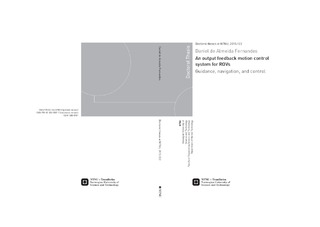An output feedback motion control system for ROVs : guidance, navigation, and control
Doctoral thesis

Åpne
Permanent lenke
http://hdl.handle.net/11250/299183Utgivelsesdato
2015Metadata
Vis full innførselSamlinger
- Institutt for marin teknikk [3437]
Sammendrag
This doctoral thesis is concerned with two main subjects, namely path generation
and motion control of observation class Remotely Operated Vehicles (ROVs).
Both of them are examined with an emphasis on the motion control problem. The
common focus renders the subjects interrelated, although they can be investigated
separately. Indeed, the investigation is carried out separately in the thesis.
The first subject dealt with is path generation. A path generation scheme concerned with the generation of sufficently smooth position, velocity, and acceleration references, for guiding the motion of ROVs along purposefully pre-defined
planar and spatial curvature- and torsion-continuous paths comprised of rectilinear and curvilinear parts, is proposed. The references are meant to be used in high-performance Motion Control Systems (MCSs) with trajectory tracking and Dynamic Positioning (DP ) capabilities.
Four Degrees-of-Freedom (DoFs) are simultaneously considered, namely surge, sway, heave, and yaw. Steadier motion can be
attained through the use of the references, which: i) induce steadier hydro dynamic
effects, thereby inducing less plant parameter variations; and ii) demand steadier thrust forces and moments from the propulsion system. Consequently, higher
overall motion accuracy can be attained, despite the challenging operating conditions underwater, while energy saving along the motion is favoured. Towards this
end, a Reference Model (RM ) that synthesises continuous position, velocity, and
acceleration references concerning a single DoF motion, either linear or angular, is
initially proposed. The RM synthesises suboptimal references with respect to the
time taken to complete the motion under the condition of constrained acceleration
and velocity. The condition of suboptimality has harmless implications in practice.
It is mostly a consequence of the fact that the RM has to reflect the desired motion spcefications and the bandwidth limitations of the MCS being fed with the
references.
The RM is easy to tune through its meaningful tuning parameters.
Two versions of the RM are proposed: i) a basic version, which guides motion
under the condition that both the initial and the final values of the velocity and
acceleration references are equal to zero; and ii) an extended version, which guides
motion under the condition that the initial and final values of the velocity reference can be different from zero, whereas both the initial and the final values
of the acceleration reference are equal to zero. Finally, the three references synthesised by the RM are used as the parametrisation of the group of references
conerning multiple DoF motion which is first and foremost the aim of the proposed path generation scheme. Even though the proposed scheme focuses only on
the (typically) fully-actuated ROVs, some of the presented ideas can be adapted
to be used as a means of also guiding the motion of (typically) underactuated
marine rafts, e.g. ships and Autonomous Underwater Vehicles (AUV s), in path
following motion control applications. The path planning problem is not in the
scope of this work. The proposed RM and the proposed path generation scheme
are two of the main contributions found in this thesis. The mathematical development, as well as the experiments and simulations carried out, focused only on
planar curvature-continuous paths.
The second subject dealt with is motion control. An MCS dedicated to control
observation class ROVs, which are used to conduct automated (high-resolution)
image-capturing missions, is proposed. The MCS essentially consists in a modelbased Multiple-Input-Multiple-Output (MIMO) output feedbak control system
that works in tandem with an open-loop guidance system. The MIMO output
feedbak control system is comprised of a MIMO Proportional-Integral-Derivative
(PID ) controller that works in combination with a High-Gain State Observer
(HGSO ).
The MIMO PID controller is aided by two additional control laws: i)
one that implements state feedbak linearisation of the plant dynamics; and ii)
another that implements reference feedforward. An elementary thrust allocation
algorithm completes the proposed MCS. The MCS has DP and trajectory tracking
capabilities. Such capabilities enable the end-users of the ROV technology, e.g.
marine archaeologists, biologists, and geologists, to obtain sequential high-quality
images at the proper pace to construt consistent representations of objects and
environments of interest.
Four DoFs are controlled, namely surge, sway, heave,
and yaw, whereas both remaining DoFs, namely roll and pitch, are left uncontrolled under the argumentation that they are self-stable - metacentric stability -
by the design of the ROVs. Stability and satisfactory tracking performane are attainable through the use of suitable and suffiently smooth reference trajectories,
e.g. those generated by the path generation scheme also proposed in this thesis, in
spite of the presence of unmodelled plant dynamics, plant parameter variations,
measurement errors and noise, and environmental disturbances. Two other main
contributions found in this thesis are the Globally Exponentially Stable (GES )
model-based MIMO output feedbak MCS, and the verification of the hypothesis that an HGSO serves as an alternative to the benchmark Extended Kalman
Filter (EKF ) in the proposed MCS.
Results from computer simulations and full-scale sea trials, both based on the
NTNU 's ROV Minerva, are presented and disussed to supp ort the development
carried out in the thesis.